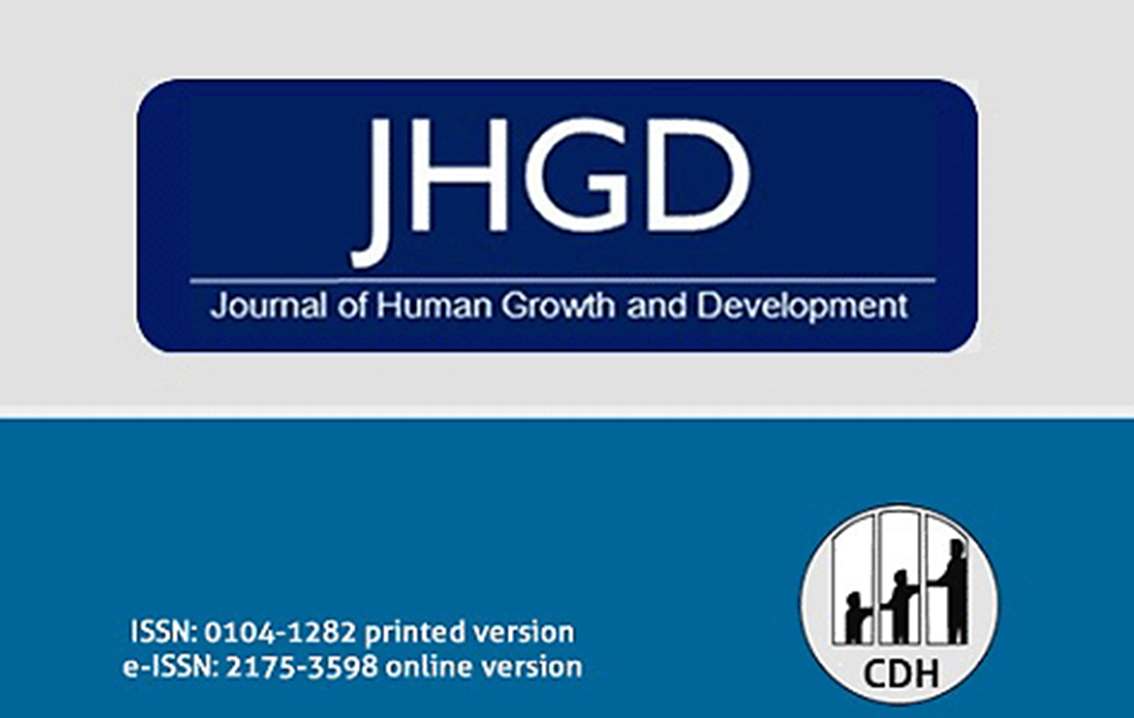Body self-perception in age school children with Down Syndrome
DOI:
https://doi.org/10.7322/jhgd.v30.9970Keywords:
Down syndrome, Self-perceived body, Child, DrawAbstract
Introduction: The notion of body or body perception is of great importance in the development of motor skills and functionality. In atypical development situations, as in the case of Down syndrome (DS) there is a delay in the development and motor skills are compromised, which possibly is reflected in the quality of body self-perception in children with DS.
Objective: To assess the characteristics of body self-perception in school age children with DS.
Methods: This is an exploratory and descriptive study involving 10 children aged between seven and nine years. To assess body perception, it was used the Body Notion factor from the Psychomotor Battery (BPM). Data analysis was performed qualitatively and quantitatively according to the criteria established by the instruments and the researchers.
Results: The participants' performance regarding the notion of body was not related to their age. The right and left discrimination capability was the body notion sub-factor with the worst performance and the self-image was the sub-factor with the best performance. The drawings of the human figure were split into two categories: unidentifiable (Class A, n = 8) and recognizable (Class B, n = 2).
Conclusion: It is suggested that the self-perception of children with Down Syndrome analyzed in this study has a strong relationship with the body and environmental stimuli together with psychomotor and cognitive development, which, however, does not coincide with their chronological age.
Downloads
References
2. Brêtas JRS, Pereira SR, Cintra CC, Amirati KM. Avaliação de funções psicomotoras de crianças entre 6 e 10 anos de idade. Acta Paul Enferm. 2005;18(4):403-12. DOI: http://doi.org/10.1590/S0103-21002005000400009
3. Leal IA. Poder de projetar-se do ser no mundo em Merleau-Ponty. Princípios Rev Filosof. 2012;19(32):393-417.
4. Simons J, Leitschuh C, Raymaekers A, Vandenbussche I. Body awareness in preschool children with psychiatric disorder. Res Dev Disabil. 2011;32(5): 1623-30. DOI: http://dx.doi.org/10.1016/j.ridd.2011.02.011
5. Arya R, Kabra M, Gulati S. Epilepsy in children with Down syndrome. Epileptic Disord. 2011;13(1):1-7. DOI: http://dx.doi.org/10.1684/epd.2011.0415
6. Coelho C. A síndrome de Down. [cited 2019 Apr 01] Available from: https://www.psicologia.pt/artigos/textos/A0963.pdf
7. Silva MNS, Santos KMB, Andrade LM, Zanona AF. Avaliação funcional do desenvolvimento psicomotor e ambiente familiar de crianças com síndrome de down. Rev Interinst Bras Ter Ocup. 2017;1(2):186-201.
8. Bonomo LMM, Rossetti CB. Aspectos percepto-motores e cognitivos do desenvolvimento de crianças com Síndrome de Down. Rev Bras Cresc Desenv Hum. 2010;20(3):723-34. DOI: https://doi.org/10.7322/jhgd.19980
9. Campos AC, Savelsbergh GJ, Rocha NA. What do we know about the atypical development of exploratory actions during infancy? Res Dev Disabil. 2012;33(6):2228-35. DOI: http://doi.org/10.1016/j.ridd.2012.06.016
10. Wang HI, Long IM, Liu MF. Relationship between motor skill competency and executive function in children with Down’s syndrome. Res Dev Disabil. 2012;33(6):1792-8. DOI: http://doi.org/10.1016/j.ridd.2012.05.002
11. Pereira K, Basso RP, Lindquist, ARR, Silva LGP, Tudella E. Infants with Down syndrome: percentage and age for acquisition of gross motor skills. Res Dev Disabil. 2013;34(3):894–901. DOI: http://doi.org/10.1016/j.ridd.2012.11.021
12. Skotko BG, Levine SP, Goldstein R. Self-perceptions from people with Down Syndrome. Am J Med Genet Part A. 2011;155A(10):2360-9 DOI: http://doi.org/10.1002/ajmg.a.34235
13. Brunamonti E, Pani P, Papazachariadis O, Onorati P, Albertini G, Ferraina S. Cognitive control of movement in down syndrome. Res Dev Disabil. 2011;32(5):1792-7. DOI: https://doi.org/10.1016/j.ridd.2011.03.008
14. Polastri PF, Barela JA. Perception-action coupling in infants with Down syndrome: effects of experience and practice. Adapt Phys Act Q. 2005;22(1): 39-56. DOI: https://doi.org/10.1123/apaq.22.1.39
15. Camargos ACR, Fontes PLB, Araújo APS, Silva FC, Pereira, LP, Souza SMF. Desenvolvimento motor de crianças pré- termo moderada aos sete e oito anos de idade. Fisioter Pesqui. 2011;18(2):182-7. DOI: https://doi.org/10.1590/S1809-29502011000200014
16. Askevold F. Measuring body image. Preliminary reporto on a new method. Psycother Psychosom 1975;26(2):71-7. DOI: http://dx.doi.org/10.1159/000286913
17. Souza SHV. A Criança e a Expressão do Pensamento através do Grafismo. Rev Thema. 2012;9(2):1-23
18. Dal-Farra RA, Lopes PTC. Métodos mistos de pesquisa em educação: pressupostos teóricos. Nuances: Estud Educ. 2013:24(3):67-80. DOI: http://dx.doi.org/10.14572/nuances.v24i3.2698
19. Pereira K, Tudella E. Perfil psicomotor de escolares: quanto ao gênero, à idade gestacional e ao aspecto físico. Fisioter Mov. 2008;21(1) 47-55.
20. Felício SR, Gava NM, Zanella RC, Pereira K. Marcha de crianças e jovens com síndrome de Down. ConScientiae Saúde. 2008;7(3):349-56. DOI: https://doi.org/10.5585/conssaude.v7i3.1326
21. Meneghetti CHZ, Blascovi-Assis SM, Deloroso FT, Rodrigues GM. Avaliação do equilíbrio estático em crianças e adolescentes com Síndrome de Down. Rev Bras Fisioter. 2009;13(3):230-5. DOI: http://dx.doi.org/10.1590/S1413-35552009005000029
22. Eiras LFG, Amorim BB, Carmo NM, Russo MM. Construção da imagem corporal em deficientes visuais. Rev Arq Mov. 2012;8(2):94-110.
23. Bissoto ML. O desenvolvimento cognitivo e o processo de aprendizagem do portador da Síndrome de Down: revendo concepções e perspectivas educacionais. Rev Ciêncs Cog. 2005;4:80-8.
24. Souza RM, Teixeira LA. Sobre a relação entre filogenia e ontogenia no desenvolvimento da lateralidade na infância. Psicol Reflex Crit. 2011;24(1):62-70. DOI: http://dx.doi.org/10.1590/S0102-79722011000100008
25. Serafim G, Peres LS, Corseuil HX. Lateralidade: conhecimentos básicos e fatores de dominância em escolares de 7 a 10 anos. Cad Ed Fís. 2000;2(1):11-30.
26. Santos GL, Bueno TB, Tudella T, Dionísio J. Preferência podal em lactentes com síndrome de Down: fatores extrínsecos e intrínsecos. Fisioter Pesq. 2012; 19(2):171-7. DOI: http://dx.doi.org/10.1590/S1809-29502012000200014
27. Piaget J, Inhelder B. A psicologia da criança. 7 ed. São Paulo: Difel, 1982.
28. Meltzoff AN, Moore MK. Imitation in Newborn Infants: Exploring the Range of Gestures Imitated and the Underlying Mechanisms. Develop Psych. 1989; 25(6):954-62. DOI: http://dx.doi.org/10.1037/0012-1649.25.6.954
29. Jones SS. The development of imitation in infancy. Philos Trans R Soc Lond B Biol Sci. 2009; 364(1528):2325-35. DOI: http://doi.org/10.1098/rstb.2009.0045
30. Barbosa RG, e Batista IL. Vygotsky: Um Referencial para Analisar a Aprendizagem e a Criatividade no Ensino da Física. Rev Bras Pesq Educ Ciênc. 2018;1:49-67.
31. Rodrigues MH. Análise do desenho infantil segundo as ideias de Luquet. Rev Unifebe. 2010;1(8):19-34.
32. Luquet GH. O desenho infantil. Lisboa: Companhia Editora do Minho, 1989.






